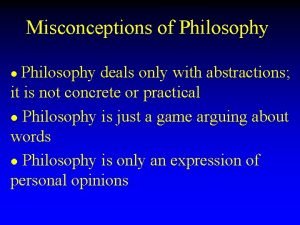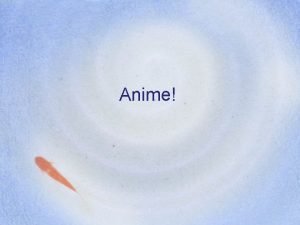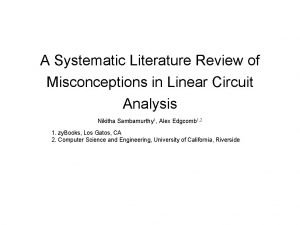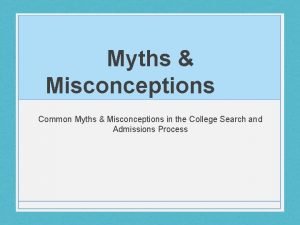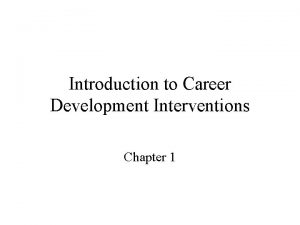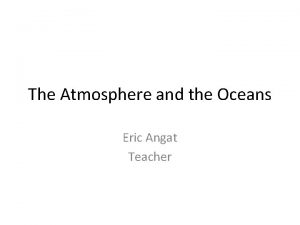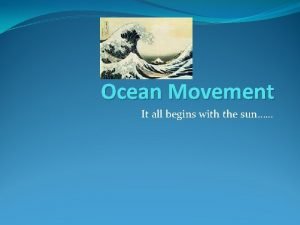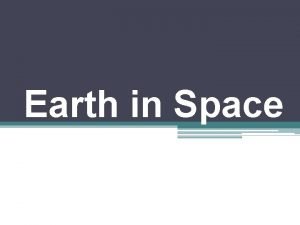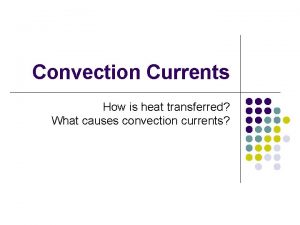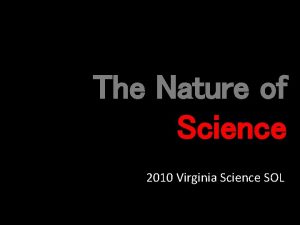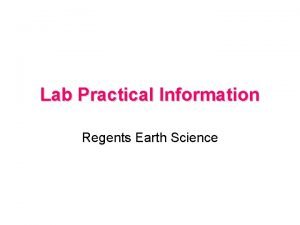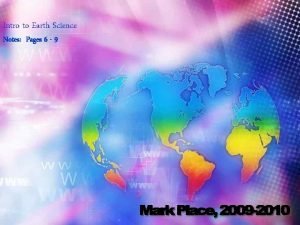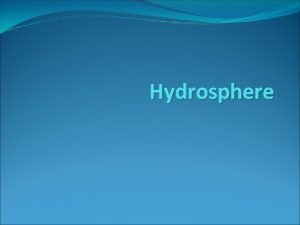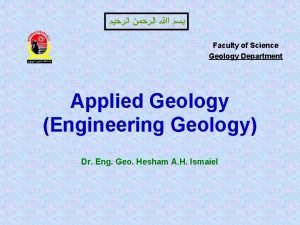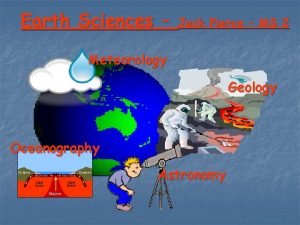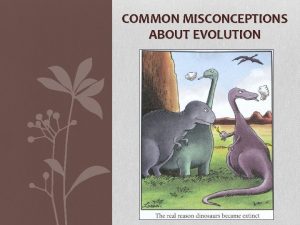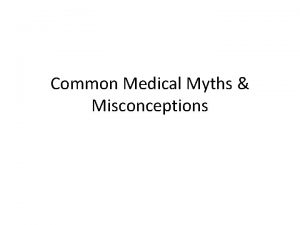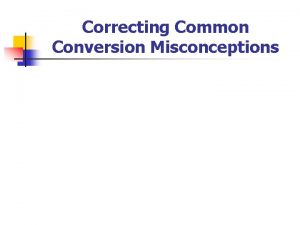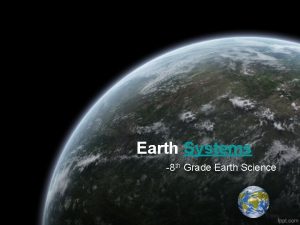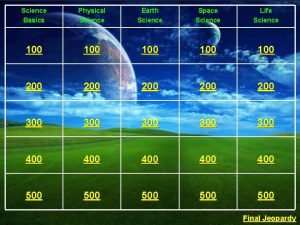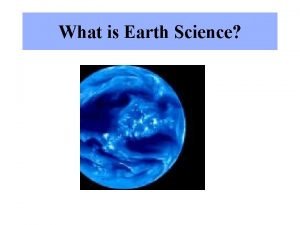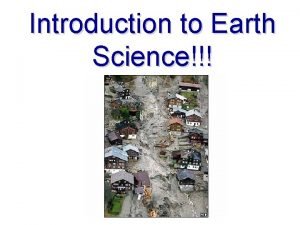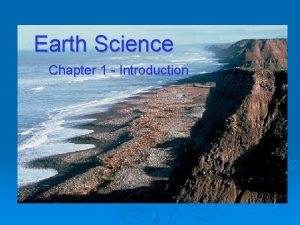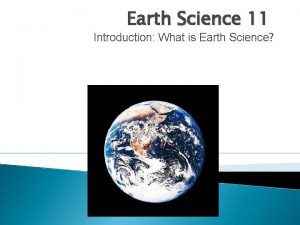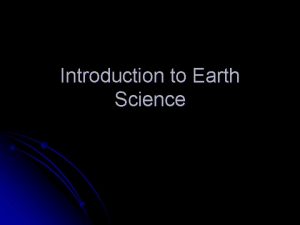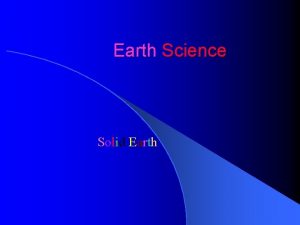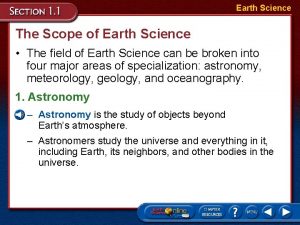Misconceptions In Earth Science 3 Misconceptions What causes































- Slides: 31

Misconceptions In Earth Science

3 Misconceptions • What causes the seasons? • What causes the tides? • Where does molten rock come from?

Seasons • Many people believe that seasons are due to varying distance from the Sun (A Private Universe) • We know planetary orbits are ellipses • And planets closer to the Sun get more heat

• However variation in circularity of earth’s orbit is small (called eccentricity of the orbit) only 5, 000 km in 150, 000 km • Changes heat by 0. 1% • Not enough to explain seasons

• Besides, the earth is actually closest to the sun during our winter (approx. Jan 3).

• And we all know that seasons are reversed in the Southern Hemisphere – so obviously distance can’t be that important Note: difference in distance between hemispheres is very small ~6000 km or ~0. 003% of distance to Sun

• The real cause is the tilt of the earth’s axis with more radiation received by a hemisphere when that end of axis is toward Sun Explains why we can get fresh oranges in the fall and apples in spring from S. Africa and New Zealand.

Tides • Most coastlines have 2 high and 2 low tides per day.

Tides • Many people think that 1 high tide is due to the moon and the other due to the sun. • If this were true then one high tide would always occur just after noon every day. Is this true?

• The two high tides per day are both produced by the gravitational attraction of the moon • The one nearest the moon is simply pulled toward the moon.

• Note: The earth spins on its axis once per day while the moon takes 28 days to complete an orbit. • Thus, on the surface of the earth, we pass into and out of these water bulges as the earth rotates, causing tidal rises and falls.

• But what causes the bulge on the side away from the moon? It’s also the moon. You can either think of the moon pulling the earth away from the bulge on the other side, or think of the “centrifugal force” of the spinning earth-moon pair.


• So what affect does the Sun have, if any? • There is a Solar tide but it is much smaller than the lunar tide because the sun is so far away.

• When the moon, earth, and sun are approx. in line, the tides add up making extreme “Spring” tides

• When the moon, sun and earth are at right angles, the solar tide “subtracts” from the lunar tide making “Neap” tides.

• Note that “Spring tides” should only occur around full moon or new moon phases

Molten Rock • Many people believe large portions of the earth’s interior are molten and that lava (magma) comes from these “molten zones. ”

• Although the outer core of the earth is molten, it is very deep (2, 900 km) and composed of iron and nickel. • Lava (magma) does not come from the core. • The mantle, just below the crust, is primarily a plastic solid.

• Magma is produced when rocks are subjected to temperature/pressure/chemical conditions which cause melting. • The melt is less dense than the rocks and will rise toward the surface.

• The idea that melted rock would be less dense than solid rock may seem strange – only because we are familiar with water in which the solid (ice) is less dense than the liquid. • Most substances are not like water.

• Ice can be melted by applying pressure.

• Hot rocks can melt when pressure is reduced.

• Temperature increases with increasing depth due to radioactivity and residual heat • The pattern is called “Geothermal Gradient. ”

• Despite very high temperatures, most of the mantle remains solid because the high pressures “keep” it from melting.

• At divergent plate tectonics boundaries hot mantle rocks rise toward the surface as the crust separates.

• As the mantle material rises, pressure is reduced, leading to partial melting. • The magma produced rises through cracks and fissures.

• A similar condition exists for volcanoes like Hawaii where a plume of hot plastic mantle rock rises beneath the crust. • Partial melting occurs as pressure drops and the melt rises through cracks in the crust.

• Melting can also be caused by addition of compounds like water to hot rocks. • In subduction zones, sediments carry water which permeates both the down-going lithosphere and the overlying mantle causing melting.

• Thus, volcanoes exist where conditions create melting in the crust and/or mantle through temperature, pressure or chemical changes.

Conclusion • Research has shown that many people will return to their misconception unless they can be shown that their previous ideas fail obvious tests.
 Common misconceptions about computer science
Common misconceptions about computer science My favorite subject is pe
My favorite subject is pe Aristotle vs galileo view of motion
Aristotle vs galileo view of motion Misconceptions about philosophy
Misconceptions about philosophy Anime
Anime Misconceptions about literature review
Misconceptions about literature review Common psychology misconceptions
Common psychology misconceptions Misconceptions about learning disabilities
Misconceptions about learning disabilities Misconceptions of multicultural education
Misconceptions of multicultural education Forumlaic
Forumlaic What is linguistic
What is linguistic Career development introduction
Career development introduction Proximate vs ultimate causation
Proximate vs ultimate causation Proximate and ultimate behavior examples
Proximate and ultimate behavior examples Heating of the earth's surface causes
Heating of the earth's surface causes Type of currents
Type of currents What is causes day and night
What is causes day and night Causes of convection currents
Causes of convection currents What letters designate an air mass from the gulf of mexico?
What letters designate an air mass from the gulf of mexico? Earth science sol 2010
Earth science sol 2010 Earth science lab practical review
Earth science lab practical review Earth science part d
Earth science part d Earth science lab practical
Earth science lab practical Earth science grade 9
Earth science grade 9 Dynamic equilibrium earth science
Dynamic equilibrium earth science The hydrosphere includes the
The hydrosphere includes the Fcat science 8th grade
Fcat science 8th grade Geology earth science definition
Geology earth science definition Pa state tree
Pa state tree Earth science meaning
Earth science meaning Astronomy definition earth science
Astronomy definition earth science Earth science sol
Earth science sol



